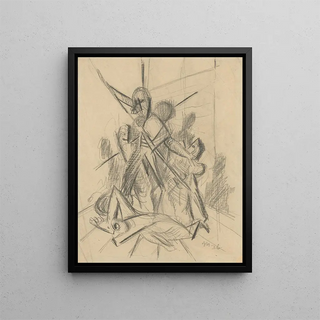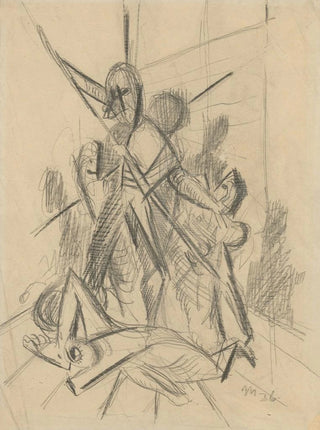Art print Study of death for the painting The Night of Saint Bartholomew - Cyprian Majernik


View from behind

Frame (optional)
In the vast panorama of art history, certain works stand out for their ability to capture profound emotions and significant historical moments. The “art print Étude de la mort pour le tableau La Nuit de la Saint-Barthélemy - Cyprian Majernik” sits at the crossroads of these two dimensions. This painting, both tragic and powerful, evokes a dark event in French history, the tragic night of August 24, 1572, when thousands of Protestants were massacred in Paris. Majernik, through his approach, invites us to contemplate not only the violence of this act but also the fragility of human life. Through this work, the artist immerses us in a reflection on death and memory, while offering a window into a turbulent era.
Style and uniqueness of the work
Majernik's style is characterized by a remarkable mastery of chiaroscuro, a technique that creates striking contrasts between light and shadow. In this study, the light seems to play a narrative role, illuminating the faces of the victims while plunging the executioners into darkness, as if to emphasize humanity's duality. The expressions of the characters, alternately desperate and stoic, reveal a psychological depth that transcends the simple historical painting. The color palette, dominated by dark and earthy tones, enhances the heavy and tragic atmosphere of the scene. Majernik succeeds in capturing the very essence of human suffering, while offering a harmonious and balanced composition that guides the viewer's gaze across the painting.
The artist and his influence
Cyprian Majernik is an artist whose journey is marked by an unceasing quest for truth and emotion. Originating from a rich artistic tradition, he draws inspiration from the masters of the past while seeking to express a personal and contemporary vision. His work is not limited to the simple depiction of historical events; it aims to be a reflection on the human condition, on the struggles and sufferings that punctuate our history. Majernik has established himself as

Matte finish

View from behind

Frame (optional)
In the vast panorama of art history, certain works stand out for their ability to capture profound emotions and significant historical moments. The “art print Étude de la mort pour le tableau La Nuit de la Saint-Barthélemy - Cyprian Majernik” sits at the crossroads of these two dimensions. This painting, both tragic and powerful, evokes a dark event in French history, the tragic night of August 24, 1572, when thousands of Protestants were massacred in Paris. Majernik, through his approach, invites us to contemplate not only the violence of this act but also the fragility of human life. Through this work, the artist immerses us in a reflection on death and memory, while offering a window into a turbulent era.
Style and uniqueness of the work
Majernik's style is characterized by a remarkable mastery of chiaroscuro, a technique that creates striking contrasts between light and shadow. In this study, the light seems to play a narrative role, illuminating the faces of the victims while plunging the executioners into darkness, as if to emphasize humanity's duality. The expressions of the characters, alternately desperate and stoic, reveal a psychological depth that transcends the simple historical painting. The color palette, dominated by dark and earthy tones, enhances the heavy and tragic atmosphere of the scene. Majernik succeeds in capturing the very essence of human suffering, while offering a harmonious and balanced composition that guides the viewer's gaze across the painting.
The artist and his influence
Cyprian Majernik is an artist whose journey is marked by an unceasing quest for truth and emotion. Originating from a rich artistic tradition, he draws inspiration from the masters of the past while seeking to express a personal and contemporary vision. His work is not limited to the simple depiction of historical events; it aims to be a reflection on the human condition, on the struggles and sufferings that punctuate our history. Majernik has established himself as
12,34 €






